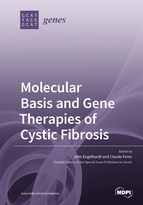Molecular Basis and Gene Therapies of Cystic Fibrosis
A special issue of Genes (ISSN 2073-4425). This special issue belongs to the section "Human Genomics and Genetic Diseases".
Deadline for manuscript submissions: closed (31 March 2020) | Viewed by 76952
Special Issue Editors
Interests: pathogenesis of cystic fibrosis lung and pancreatic disease; the development of animal models of cystic fibrosis; gene therapy of cystic fibrosis; lung stem cell biology
Interests: genetics of cystic fibrosis; genetics of pancreatitits and pancreatic diseases; genetics of autosomal dominant polycystic kidney disease (ADPKD); genetics of haemochromatosis; genetics of intellectual disability; genetics of hip dysplasia
Special Issue Information
Dear Colleagues,
The journal Genes is pleased to announce a Special Issue entitled “Molecular Basis and Gene Therapies of Cystic Fibrosis”, which is seeking original research contributions. Topics areas in this Special Issue will include three broad areas relevant to developing molecular therapies for cystic fibrosis (CF): (1) molecular mechanisms of CFTR regulation, (2) disease pathogenesis, and (3) genetic therapies for CF. Research areas may include but are not limited to:
1) Molecular mechanisms of CFTR regulation.
- CFTR gene regulation
- Post-transcriptional regulation of CFTR
- CFTR regulation at the cellular level
- Regulation of CFTR channel function
2) Disease pathogenesis
- Genotype/phenotype correlation
- Molecular epidemiology of CF
- Animal models of CF
- Cellular models of CF disease processes
- Cellular mechanisms of CF disease processes and CFTR function
- Mechanisms of CF pathogenesis (lung, pancreas, liver, intestine, and other affected organs)
- Molecular diagnosis, genetic counseling, and penetrance of CFTR variants
3) Genetic therapies for cystic fibrosis.
- Gene editing
- Gene replacement
- Vector development
- Testing of gene therapies in animal models
Dr. John Engelhardt
Dr. Claude Ferec
Dr. Ziying Yan
Guest Editors
Manuscript Submission Information
Manuscripts should be submitted online at www.mdpi.com by registering and logging in to this website. Once you are registered, click here to go to the submission form. Manuscripts can be submitted until the deadline. All submissions that pass pre-check are peer-reviewed. Accepted papers will be published continuously in the journal (as soon as accepted) and will be listed together on the special issue website. Research articles, review articles as well as short communications are invited. For planned papers, a title and short abstract (about 100 words) can be sent to the Editorial Office for announcement on this website.
Submitted manuscripts should not have been published previously, nor be under consideration for publication elsewhere (except conference proceedings papers). All manuscripts are thoroughly refereed through a single-blind peer-review process. A guide for authors and other relevant information for submission of manuscripts is available on the Instructions for Authors page. Genes is an international peer-reviewed open access monthly journal published by MDPI.
Please visit the Instructions for Authors page before submitting a manuscript. The Article Processing Charge (APC) for publication in this open access journal is 2600 CHF (Swiss Francs). Submitted papers should be well formatted and use good English. Authors may use MDPI's English editing service prior to publication or during author revisions.
Keywords
- CFTR
- Pathogenesis
- Gene therapy
- Animal models
- Vector development
- Genotype/phenotype
- Lung
- Pancreas
- CFTR regulation
- Epidemiology








